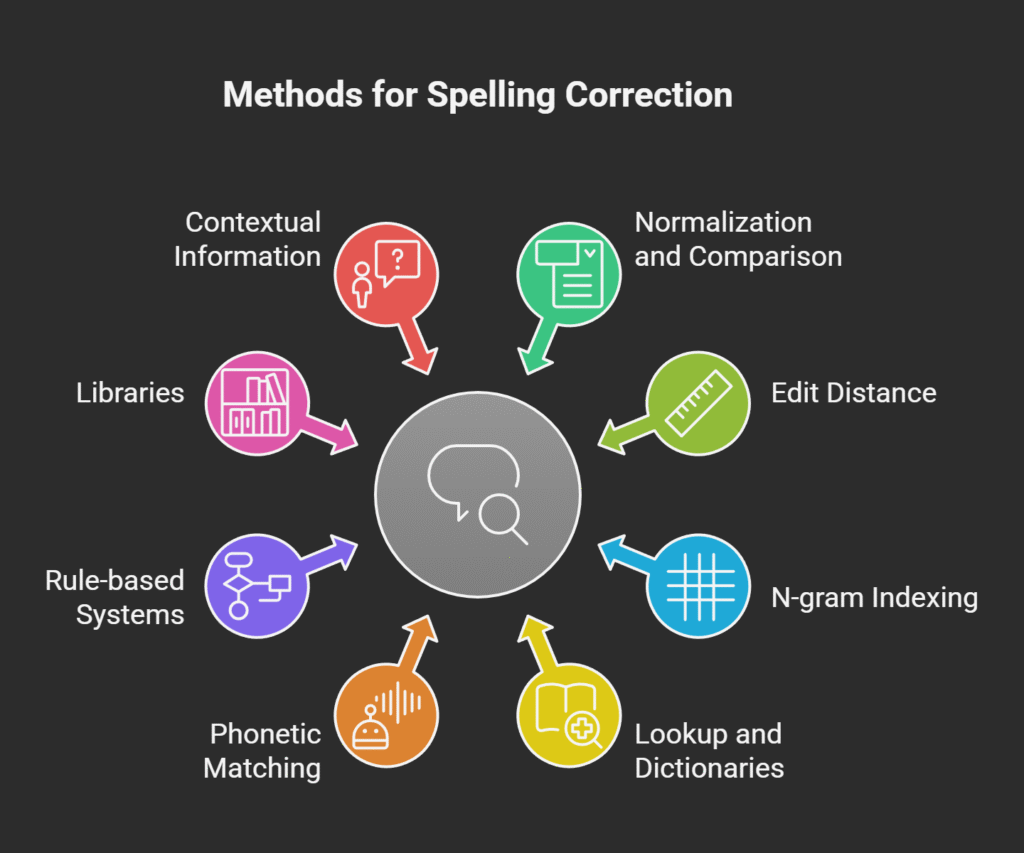NLP Spelling correction
In Natural Language Processing (NLP), spelling correction is a crucial task, especially when working with real-world text data that frequently contains errors and inconsistencies. It is regarded as a type of normalization of text.

Why Spelling Correction is Necessary
Misspellings, irregular punctuation, irregular spacing, and other irregular elements are common in real-world text data, including customer evaluations, blogs, tweets, newswire texts, email messages, closed captioning data, Internet news pages, and weblogs. With these kinds of texts, algorithms that require well-formed input perform worse.
There are orthographic variations that go beyond basic typos. Different countries may have different spellings (for example, “colour” versus “colour”), or different spellings may be accepted (“foetus” and “foetus”). The same terms are also spelt differently in historical records. Variations can also result by transliterating foreign names.
Spelling mistakes and variations can have a big influence on NLP applications, such search algorithms, which may disregard relevant documents written with different spellings or be unable to retrieve relevant items.
What Spelling Correction Involves?
The goal of spelling correction is to find and fix writing errors. This involves standardising material by transforming variations into a more uniform form and fixing basic typographical errors (“retreival” for “retrieval”). It assists in cutting down on the number of instances of words that have the same meaning but are spelt differently (such as “processing” and “proccessing”).
Applications of Spelling Correction
Spelling correction is crucial for a number of NLP systems and tasks:
- Search engines and information retrieval (IR) systems are crucial for managing user enquiries and document content that contains typos or orthographic variants.
- Writing Tools: Applied to grammar and spelling checkers. Contextual mistakes can occasionally be addressed by more complex checkers.
- Error analysis uses automatic speech recognition (ASR) to identify common misrecognitions. Due in part to the possibility of errors, correcting user utterances in dialogue systems can be difficult.
- Morphological Analysis: Understanding word structure requires the ability to handle morphology-based orthographic spelling variance, or spelling standards.
- Lexical Resources: Distributional word similarity and orthographic similarity can be combined to identify spelling variations and common typos. When users may struggle with spelling, lexicons can be of tremendous assistance.
Also Read About Types Of Lexicon: A Complete Guide To Word Resources
- Machine Aided Translation: Among the features that assist human translators are grammar and spelling checks.
Methods for Spelling Correction and Handling Variation

Methods for dealing with orthographic variance and spelling Correction:
Normalization and Comparison
Conventional tactics entail comparing forms that are similar. This can be accomplished by normalizing variants with a specific standard form and comparing various forms.
Edit Distance
Based on the quantity of insertions, deletions, and substitutions required to transform one string into another, the minimal edit distance between two strings measures how similar they are. Edit distance is a measure of similarity that is helpful in applications such as spelling correction and is used to identify possible remedies for spelling errors. The minimal edit distance is used in ASR to calculate the word error rate (WER).
N-gram Indexing
Using an n-gram indexing strategy (such as 5-grams) is a quick and reliable way to lessen the detrimental effects of orthographic variance and spelling mistakes. It is resistant to typographical errors and doesn’t require any prior language expertise. Spelling correction is another application for n-grams.
Lookup and Dictionaries
Spelling checkers have the ability to identify words that are not listed in dictionaries. Short words and abbreviations can be standardized in texts by using custom dictionaries. Having a vocabulary is quite beneficial for people who have trouble with spelling.
Phonetic Matching
Tools such as Soundex and Metaphone build encoded versions of words to match words that have different spellings but sound similar. For chores like spelling correction, this is helpful.
Rule-based Systems (Finite State Transducers)
The preferred model for managing morphology-based orthographic spelling variation (spelling rules) is the Finite State Transducer (FST). Spelling rules specify what is changed, where it occurs, and when it occurs at different levels of representation. In addition to handling phenomena like character insertion (“glasses”, “flies”) and substitution (“flies”), FSTs encode the relationship between underlying and surface forms. They can identify boundaries and use transitions that correspond to character pairs to map between two representations. To use morphological analyzers with great precision, one must have access to a vocabulary of regular stems.
Libraries
Spelling correction can be done with libraries like TextBlob and autocorrect.
Contextual Information
Sometimes spelling corrections necessitate taking the word’s context into account. For example, the intended word sense may influence the proper spelling. Finding spelling variations and errors can be aided by the use of orthographic similarities and contextual word embeddings.
Also Read About Morphological Analysis NLP: Stemming, Lemmatization & More
While Unicode’s case-folding adds additional transformations for case-insensitive cross-language comparisons and simple lowercasing is a fundamental form of text normalization, these techniques are different from the ones explicitly discussed for fixing spelling mistakes or managing orthographic variation in supplied for this query. In order to map variations that produce wrong or non-standard word forms to correct or standard forms, spelling correction employs methods such as edit distance, n-grams, phonetic matching, and morphological rules.
